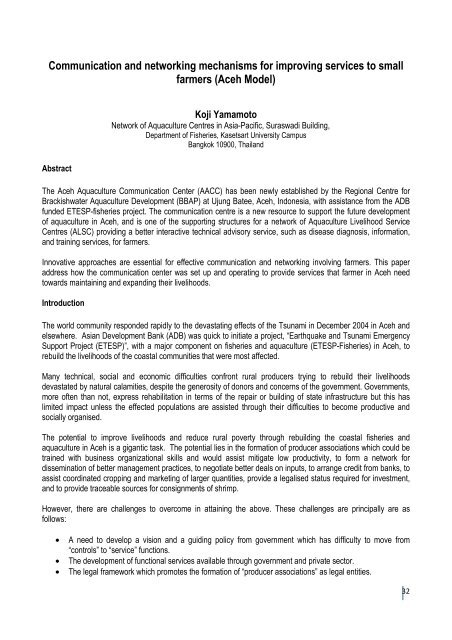Training of Trainers - Library - Network of Aquaculture Centres in ...
Training of Trainers - Library - Network of Aquaculture Centres in ...
Training of Trainers - Library - Network of Aquaculture Centres in ...
- No tags were found...
You also want an ePaper? Increase the reach of your titles
YUMPU automatically turns print PDFs into web optimized ePapers that Google loves.
Communication and network<strong>in</strong>g mechanisms for improv<strong>in</strong>g services to smallfarmers (Aceh Model)AbstractKoji Yamamoto<strong>Network</strong> <strong>of</strong> <strong>Aquaculture</strong> <strong>Centres</strong> <strong>in</strong> Asia-Pacific, Suraswadi Build<strong>in</strong>g,Department <strong>of</strong> Fisheries, Kasetsart University CampusBangkok 10900, ThailandThe Aceh <strong>Aquaculture</strong> Communication Center (AACC) has been newly established by the Regional Centre forBrackishwater <strong>Aquaculture</strong> Development (BBAP) at Ujung Batee, Aceh, Indonesia, with assistance from the ADBfunded ETESP-fisheries project. The communication centre is a new resource to support the future development<strong>of</strong> aquaculture <strong>in</strong> Aceh, and is one <strong>of</strong> the support<strong>in</strong>g structures for a network <strong>of</strong> <strong>Aquaculture</strong> Livelihood Service<strong>Centres</strong> (ALSC) provid<strong>in</strong>g a better <strong>in</strong>teractive technical advisory service, such as disease diagnosis, <strong>in</strong>formation,and tra<strong>in</strong><strong>in</strong>g services, for farmers.Innovative approaches are essential for effective communication and network<strong>in</strong>g <strong>in</strong>volv<strong>in</strong>g farmers. This paperaddress how the communication center was set up and operat<strong>in</strong>g to provide services that farmer <strong>in</strong> Aceh needtowards ma<strong>in</strong>ta<strong>in</strong><strong>in</strong>g and expand<strong>in</strong>g their livelihoods.IntroductionThe world community responded rapidly to the devastat<strong>in</strong>g effects <strong>of</strong> the Tsunami <strong>in</strong> December 2004 <strong>in</strong> Aceh andelsewhere. Asian Development Bank (ADB) was quick to <strong>in</strong>itiate a project, “Earthquake and Tsunami EmergencySupport Project (ETESP)”, with a major component on fisheries and aquaculture (ETESP-Fisheries) <strong>in</strong> Aceh, torebuild the livelihoods <strong>of</strong> the coastal communities that were most affected.Many technical, social and economic difficulties confront rural producers try<strong>in</strong>g to rebuild their livelihoodsdevastated by natural calamities, despite the generosity <strong>of</strong> donors and concerns <strong>of</strong> the government. Governments,more <strong>of</strong>ten than not, express rehabilitation <strong>in</strong> terms <strong>of</strong> the repair or build<strong>in</strong>g <strong>of</strong> state <strong>in</strong>frastructure but this haslimited impact unless the effected populations are assisted through their difficulties to become productive andsocially organised.The potential to improve livelihoods and reduce rural poverty through rebuild<strong>in</strong>g the coastal fisheries andaquaculture <strong>in</strong> Aceh is a gigantic task. The potential lies <strong>in</strong> the formation <strong>of</strong> producer associations which could betra<strong>in</strong>ed with bus<strong>in</strong>ess organizational skills and would assist mitigate low productivity, to form a network fordissem<strong>in</strong>ation <strong>of</strong> better management practices, to negotiate better deals on <strong>in</strong>puts, to arrange credit from banks, toassist coord<strong>in</strong>ated cropp<strong>in</strong>g and market<strong>in</strong>g <strong>of</strong> larger quantities, provide a legalised status required for <strong>in</strong>vestment,and to provide traceable sources for consignments <strong>of</strong> shrimp.However, there are challenges to overcome <strong>in</strong> atta<strong>in</strong><strong>in</strong>g the above. These challenges are pr<strong>in</strong>cipally are asfollows:• A need to develop a vision and a guid<strong>in</strong>g policy from government which has difficulty to move from“controls” to “service” functions.• The development <strong>of</strong> functional services available through government and private sector.• The legal framework which promotes the formation <strong>of</strong> “producer associations” as legal entities.32
















